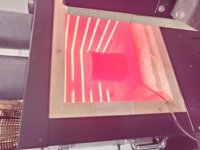xavier2089
Plastic
- Joined
- Nov 29, 2016
Hi all,
I recently watched the video below and was wondering if anyone can give me a whole lot more information on the process and its effectiveness, how to do it, etc.?
Dan Gelbart Workshop Tour HD - YouTube
23:35 minutes in...
This was the first time I have heard of the ability for ethanol to form a gaseous atmosphere which can protect the contents of a kiln from oxidising/de-carbonising. It seems an extremely cheap method of protecting parts for heat treating.
I recently bought a kiln but I will have to fill in the air gaps if I am going to try this process as there is a very poor seal around the door.
I imagine that you only need a tube that enters at the top of the oven and that gravity just drip feeds the alcohol in (probably as a gas by the time that it enters such a hot environment)?
Anyway, I would love to hear thoughts and opinions on the matter.
Cheers!
I recently watched the video below and was wondering if anyone can give me a whole lot more information on the process and its effectiveness, how to do it, etc.?
Dan Gelbart Workshop Tour HD - YouTube
23:35 minutes in...
This was the first time I have heard of the ability for ethanol to form a gaseous atmosphere which can protect the contents of a kiln from oxidising/de-carbonising. It seems an extremely cheap method of protecting parts for heat treating.
I recently bought a kiln but I will have to fill in the air gaps if I am going to try this process as there is a very poor seal around the door.
I imagine that you only need a tube that enters at the top of the oven and that gravity just drip feeds the alcohol in (probably as a gas by the time that it enters such a hot environment)?
Anyway, I would love to hear thoughts and opinions on the matter.
Cheers!


